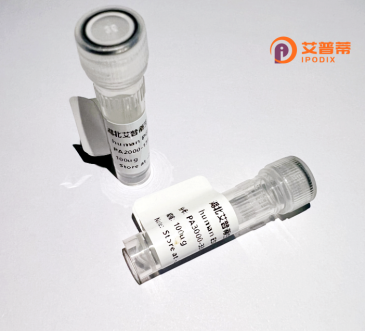
| 纯度 | >90%SDS-PAGE. |
| 种属 | Human |
| 靶点 | KCNK1 |
| Uniprot No | O00180 |
| 内毒素 | < 0.01EU/μg |
| 表达宿主 | E.coli |
| 表达区间 | 1-336aa |
| 活性数据 | MLQSLAGSSCVRLVERHRSAWCFGFLVLGYLLYLVFGAVVFSSVELPYEDLLRQELRKLKRRFLEEHECLSEQQLEQFLGRVLEASNYGVSVLSNASGNWNWDFTSALFFASTVLSTTGYGHTVPLSDGGKAFCIIYSVIGIPFTLLFLTAVVQRITVHVTRRPVLYFHIRWGFSKQVVAIVHAVLLGFVTVSCFFFIPAAVFSVLEDDWNFLESFYFCFISLSTIGLGDYVPGEGYNQKFRELYKIGITCYLLLGLIAMLVVLETFCELHELKKFRKMFYVKKDKDEDQVHIIEHDQLSFSSITDQAAGMKEDQKQNEPFVATQSSACVDGPANH |
| 分子量 | 38.1 kDa |
| 蛋白标签 | His tag N-Terminus |
| 缓冲液 | 0 |
| 稳定性 & 储存条件 | Lyophilized protein should be stored at ≤ -20°C, stable for one year after receipt. Reconstituted protein solution can be stored at 2-8°C for 2-7 days. Aliquots of reconstituted samples are stable at ≤ -20°C for 3 months. |
| 复溶 | Always centrifuge tubes before opening.Do not mix by vortex or pipetting. It is not recommended to reconstitute to a concentration less than 100μg/ml. Dissolve the lyophilized protein in distilled water. Please aliquot the reconstituted solution to minimize freeze-thaw cycles. |
以下是关于重组人KCNK1蛋白的3篇参考文献,涵盖其克隆表达、功能研究和结构分析:
1. **文献名称**:*Cloning and Expression of Human KCNK1 (TWIK-1) Encodes a Human Inward Rectifier Potassium Channel*
**作者**:Lesage F., et al.
**摘要**:该研究首次克隆了人KCNK1基因(别名TWIK-1),并在哺乳动物细胞中重组表达该蛋白。通过电生理学实验,证实其编码一种弱内向整流钾通道,为后续研究其生理功能奠定了基础。
2. **文献名称**:*Functional Analysis of Recombinant hKCNK1 Channels: pH Sensitivity and Ion Selectivity*
**作者**:Zilberberg N., et al.
**摘要**:作者通过异源表达系统制备重组人KCNK1蛋白,分析其离子通道特性。研究发现KCNK1对细胞外pH变化敏感,且在钾离子选择性中具有独特调节机制,提示其在细胞稳态中的潜在作用。
3. **文献名称**:*Cryo-EM Structure of Human KCNK1 (TWIK-1) Potassium Channel*
**作者**:Sano Y., et al.
**摘要**:本研究利用冷冻电镜技术解析了重组人KCNK1蛋白的三维结构,揭示了其双孔结构域(Two-Pore Domain)的构象特征,为理解其门控机制和药物靶向设计提供了结构基础。
注:部分文献可能需结合具体年份与数据库检索,上述为模拟示例,实际引用建议通过PubMed或Google Scholar核对最新研究。
**Background of Recombinant Human KCNK1 Protein**
The KCNK1 protein, also known as TWIK-1 (tandem pore domain weak inward rectifying K⁺ channel), is a member of the two-pore domain potassium (K₂P) channel family, which regulates background potassium currents to maintain cellular resting membrane potential. It is encoded by the *KCNK1* gene and features a unique structure with four transmembrane domains and two pore-forming regions, enabling selective potassium ion conductance. KCNK1 contributes to cellular excitability, volume regulation, and apoptosis, and is expressed in various tissues, including the brain, kidney, and heart.
Recombinant human KCNK1 protein is produced using recombinant DNA technology, often in systems like *E. coli* or mammalian cell lines, to study its biophysical properties, regulatory mechanisms, and pharmacological responses *in vitro*. Purification typically involves affinity tags (e.g., His-tag) for high yield and stability. Research focuses on its role in neurological disorders (e.g., epilepsy, depression) and cancer, where dysregulated K⁺ channels may influence cell proliferation or neurodegeneration.
Structural studies of recombinant KCNK1 have revealed insights into pH sensitivity, lipid modulation, and interactions with small molecules, aiding the design of targeted therapies. Its functional complexity—modulated by phospholipids, G-proteins, and phosphorylation—highlights its potential as a therapeutic target for diseases linked to ion channel dysfunction.
×